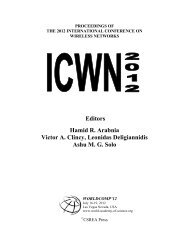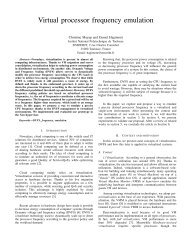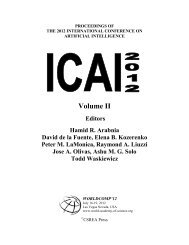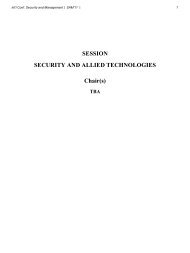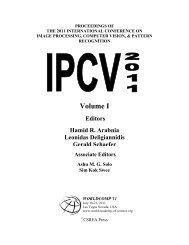SESSION NOVEL ALGORIHMS AND APPLICATIONS + ...
SESSION NOVEL ALGORIHMS AND APPLICATIONS + ...
SESSION NOVEL ALGORIHMS AND APPLICATIONS + ...
Create successful ePaper yourself
Turn your PDF publications into a flip-book with our unique Google optimized e-Paper software.
10 Int'l Conf. Foundations of Computer Science | FCS'11 |<br />
Effect of cache lines in array-based hashing algorithms<br />
Ákos Dudás 1 , Sándor Kolumbán 2 , and Tamás Schrádi 3<br />
Department of Automation and Applied Informatics,<br />
Budapest University of Technology and Economics,<br />
1117 Budapest, Magyar Tudósok körútja 2. QB-207 Hungary<br />
{ 1 akos.dudas, 2 kolumban.sandor, 3 schradi.tamas}@aut.bme.hu<br />
Abstract— Hashing algorithms and their efficiency is modeled<br />
with their expected probe lengths. This value measures<br />
the number of algorithmic steps required to find the position<br />
of an item inside the table. This metric, however, has an<br />
implicit assumption that all of these steps have a uniform<br />
cost. In this paper we show that this is not true on modern<br />
computers, and that caches and especially cache lines have<br />
a great impact on the performance and effectiveness of<br />
hashing algorithms that use array-based structures. Spatial<br />
locality of memory accesses plays a major role in the<br />
effectiveness of an algorithm. We show a novel model of<br />
evaluating hashing schemes; this model is based on the<br />
number of cache misses the algorithms suffer. This new<br />
approach is shown to model the real performance of hash<br />
tables more precisely than previous methods. For developing<br />
this model the sketch of proof of the expected probe length<br />
of linear probing is included.<br />
Keywords: hash table; hashing; linear probing; cache-aware;<br />
performance<br />
1. Introduction<br />
Hashing algorithms are a popular choice in a great variety<br />
of applications for fast storage and retrieval of items. Over<br />
the years there have been many hashing algorithms presented<br />
in the literature. These algorithms are usually compared<br />
based on the expected probe lengths [1], [2], [3], [4], that<br />
is, the number of steps the algorithm has to take before an<br />
item can be inserted into the table. (This is equivalent to<br />
the number of steps it takes to find an item. Both will be<br />
referred to as probe length throughout this paper.)<br />
It has been our observation [5], and also the suggestion<br />
of others [4], [6], that the expected probe length does<br />
not model the true performance correctly. Measuring the<br />
wall-clock execution times of the algorithms and using the<br />
expected probe length-based raking of hashing schemes we<br />
can arrive at two contradicting conclusions; in this paper we<br />
propose a solution that unify the expected probe length-based<br />
comparison and the physical capabilities of the hardware,<br />
resulting in a more precise efficiency estimation.<br />
The fact is, that the true performance of array-based<br />
hashing schemes is effected by the physical hardware it<br />
is executed on. The expected probe length-based efficiency<br />
analysis has the implicit assumption that every probe in the<br />
probe sequence has the same cost; this is not necessarily<br />
true though. Modern CPUs have fast (but small) integrated<br />
caches that mask the latency of the main system memory.<br />
Accessing data in these caches is by one or two orders of<br />
magnitude faster than reading from the main memory. These<br />
caches speed up temporally, and which is more relevant for<br />
us, spatially local memory reads.<br />
Algorithms that exploit these caches are called cache<br />
friendly [7]. What we propose in this paper is basically a<br />
new efficiency model that rewards cache friendly algorithms.<br />
We focus our attention to hashing schemes that use arrays;<br />
the basic idea however it generally applicable, and not just<br />
to hash tables but to other data intensive algorithms as well.<br />
The rest of the paper is organized as follows. Section 2<br />
presents the related literature of hash tables and their performance<br />
and complexity. The expected probe lengths of<br />
two hashing schemes are presented in Section 3 followed<br />
by the comparison of the hash tables based in the expected<br />
probe lengths and wall-clock execution times. To resolve<br />
the contradictory results new efficiency model is presented<br />
in Section 4. We conclude in Section 5 with the summary<br />
of our results.<br />
2. Related works<br />
Hash tables [8] store and retrieve items identified with a<br />
unique key. A hash table is basically a fixed-size table, where<br />
the position of an item is determined by a hash function.<br />
If the position calculated by the hash function is already<br />
occupied, a collision occurs. This collision can be resolved<br />
by storing the items externally (e.g. using a linked list), the<br />
approach of bucket hash tables; or a secondary hash function<br />
can be applied which calculates a new address for the item.<br />
Repeating this process until a free slot is found the algorithm<br />
traverses a probe path. The shorter this probe path is, the<br />
faster the hash table is.<br />
In linear probing [8] the secondary hash function calculates<br />
the next address by adding a constant (usually one)<br />
to the previous address. This, of course, is not a true hash<br />
function. However, this “laziness” is what makes linear<br />
probing cache friendly [7].<br />
There is a theoretical hashing scheme, which produces<br />
perfectly random address generation. The idea is that there



